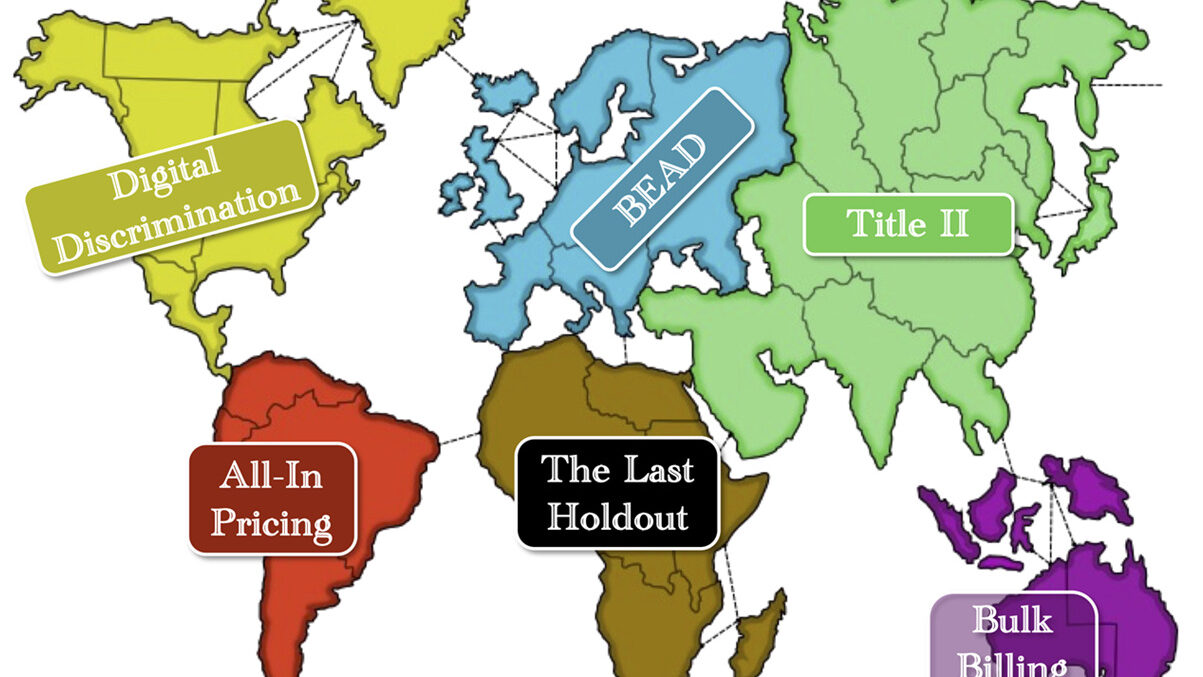
The big news in telecommunications policy last week wasn’t really news at all—the Federal Communications Commission (FCC) released its proposed rules to classify broadband internet under Title II of the Communications Act. Supporters frame the proposed rules as “net neutrality,” but those provisions—a ban on blocking, throttling, or engaging in paid or affiliated-prioritization arrangements—actually comprise just a small part of the 435-page document.
Needless to say, I haven’t had time to give the proposed rules a thorough going-over. And further needless to say, there’s not much of a rush. There’s still a couple of weeks before the vote, which will not be a nail-biter. The FCC chair can count to three and knows she has the votes to approve the rules, no matter how much the Republican commissioners squawk.
So, let’s step back and look at the broadband game board. You can think of the market as a game of Risk, where the objective is to take over every aspect of broadband. And the feds are on the march:
- With BEAD, NTIA’s taken Europe;
- With digital discrimination, the FCC took North America;
- With Title II, the FCC is poised to take Asia;
- With “all-in pricing,” the FCC grabbed South America; and
- If the FCC bans so-called “bulk billing” in multi-family housing, the agency will take Australia.
That leaves just one last continent to conquer. The feds are just a few plays away from wiping the board.
Under the Broadband Equity, Access, and Deployment (BEAD) program, the National Telecommunications and Information Administration (NTIA) imposed heavy-handed conditions to receive funding for broadband deployment.
For example, the Infrastructure Investment and Jobs Act (IIJA), which established BEAD, mandates that providers must offer at least one low-cost broadband service option for eligible low-income consumers. But the NTIA goes a step further in its notice of funding opportunity (NOFO), banning data caps and usage-based billing on these low cost plans.
While the IIJA explicitly prohibits price regulation of BEAD-funded projects, the NTIA requires that every provider offer a “middle-class affordability plan to ensure that all consumers have access to affordable high-speed internet” (emphasis in original). The NOFO provides an example of what such plans could look like, and they look a lot like price regulation.
As we noted earlier, several states have complained about NTIA’s “fiber-above-all” preference and its “Buy American” requirements.
We’ve written quite a bit about the FCC’s expansive digital-discrimination rules. They cover any entity even remotely associated with accessing broadband internet and every aspect of broadband delivery—from deployment to quality of service to pricing to marketing and advertising. If the digital-discrimination rules survive court scrutiny, every organization involved in broadband access will have the FCC serving as the proverbial policeman at the elbow.
In Risk, if you’ve got both Europe and North America, you’re in a pretty good position, but the game’s not over … so Onward to Asia!
In April’s open meeting, the FCC will vote on classifying broadband internet under Title II, subjecting the industry to public-utility-style regulation. Over time, the pitch that Title II would ensure “net neutrality” has become shopworn and less relevant. The practices the rules would ban—blocking, throttling, and paid prioritization—aren’t seen that often and, when they are, no one seems to notice or care.
The real mischief of Title II comes with the catch-all “general conduct” rules that can apply to a wide range of policies or practices. For example, the proposed rules hint that the FCC may “take action” against zero-rating practices. In addition, the rules also hint that the FCC may have more than a little interest in regulating data caps and usage-based billing.
Title II and digital-discrimination rules also serve as force multipliers for one another. Just about every practice in the entire broadband sector would be covered by one or both of these sets of rules.
By this point, if you’ve got the “Big Three” continents, it’s almost game over for your opponents. It’s just a matter of conquering the little guys. South America was smashed in March, with the FCC’s “all-in” pricing rules, which go hand-in-hand with the agency’s earlier “broadband nutrition label” rule requiring detailed disclosure of providers’ pricing and terms of service.
Next up is Australia, which could be swept up with the FCC’s proposed ban on bulk billing, which would require multi-family housing owners to open their buildings to any internet provider the tenants want to use. Overall, this may seem like small-ball stuff, but if you wanna win the game, you gotta run the board.
That leaves just one continent holding out. When the game hits this point, it’s just a matter of time, unless that holdout has a ton of lucky dice rolls. But, stranger things have happened.




